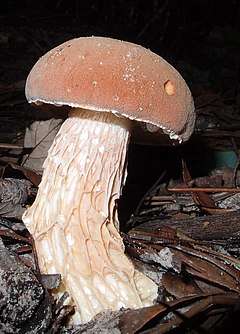Austroboletus occidentalis
| Austroboletus occidentalis | |
|---|---|
 | |
| Scientific classification | |
| Kingdom: | Fungi |
| Division: | Basidiomycota |
| Class: | Agaricomycetes |
| Order: | Boletales |
| Family: | Boletaceae |
| Genus: | Austroboletus |
| Species: | A. occidentalis |
| Binomial name | |
| Austroboletus occidentalis Watling & N.M.Gregory (1986) | |
Austroboletus occidentalis, commonly known as the ridge-stemmed bolete, is a species of bolete fungus found in Australia. It was described as new to science in 1986 by mycologists Roy Watling and Norma M. Gregory.[1] The species name occidentalis is derived from the Latin occidens "west".[2]
The fruit body has a 5.5–10 cm diameter cap that has a texture reminiscent of suede or chamois and can be sticky when young. Initially orange- or pinkish-brown, it is subconical with a thickened margin, and flattens with age and fades an ochre colour. Like other boletes, it has tubes under the cap instead of gills. These are white in young specimens maturing to pink. The cylindrical white stipe is 7–16 cm tall and 1.7–2.5 cm wide, marked with deep lacunae.[3] The white flesh bruises yellowish and has a bitter taste. The edibility is unknown. The spore print is brown, the spores 15–19 x 5–6.5 μm and covered entirely with warty lumps.[3]
Austroboletus occidentalis is a component of jarrah (Eucalyptus marginata) forests in southwestern Western Australia.[4] It has been found in coastal scrub in southeastern Tasmania.[5]
A. occidentalis establishes a new type of plant-fungus symbiosis with jarrah (Eucalyptus marginata), which has been described recently. The presence of A. occidentalis is associated with increased growth and nutrient uptake in jarrah seedlings, despite the fact that mycorrhizal structures were not recovered from the roots of the eucalypt (no root colonization). Chemical and genetic analysis of the soil and plants showed that fungal hyphae were nearby the roots and that plants had increased levels of nutrients including phosphorus, nitrogen, sulphur, magnesium, and several trace elements. Furthermore, the 33P uptake study revealed that fungal hyphae do not transfer nutrient directly to plants. Mobilization and solubilization of nutrients from minerals and soil particles could be one of the underlying mechanisms as the concentration of carboxylates in the rhizosphere soil is higher in plants involved in this symbiosis. However, there might be other unknown mechanisms behind the remarkable improvements in plant growth and nutrition.[6]
References
- ↑ Watling R, Gregory NM (1986). "Observations on the boletes of the Cooloola sandmass, Queensland and notes on their distribution in Australia: Part 3. Lamellate taxa". Proceedings of the Royal Society of Queensland. 97: 97–128. doi:10.1017/S0960428600003085.
- ↑ Simpson DP. (1979) [1854]. Cassell's Latin Dictionary (5 ed.). London: Cassell Ltd. p. 407. ISBN 0-304-52257-0.
- 1 2 Bougher NL, Syme K (1998). Fungi of Southern Australia. Nedlands, Western Australia: University of Western Australia Press. p. 300. ISBN 978-1-875560-80-6.
- ↑ Dell B, Havel JJ, Malajczuk N (2012). The Jarrah Forest: A complex mediterranean ecosystem. New York, New York: Springer Science & Business Media. p. 91. ISBN 9789400931114.
- ↑ Ratkowsky DA, Gates GM (2005). "An inventory of macrofungi observed in Tasmanian forests over a six-year period" (PDF). Tasforests. 16: 153–68. Archived from the original (PDF) on 2013-12-29.
- ↑ Kariman K, Barker SJ, Jost R, Finnegan PM, Tibbett M (2014). "A novel plant–fungus symbiosis benefits the host without forming mycorrhizal structures". New Phytologist. 201 (4): 1413–22. doi:10.1111/nph.12600. PMID 24279681.
External links
